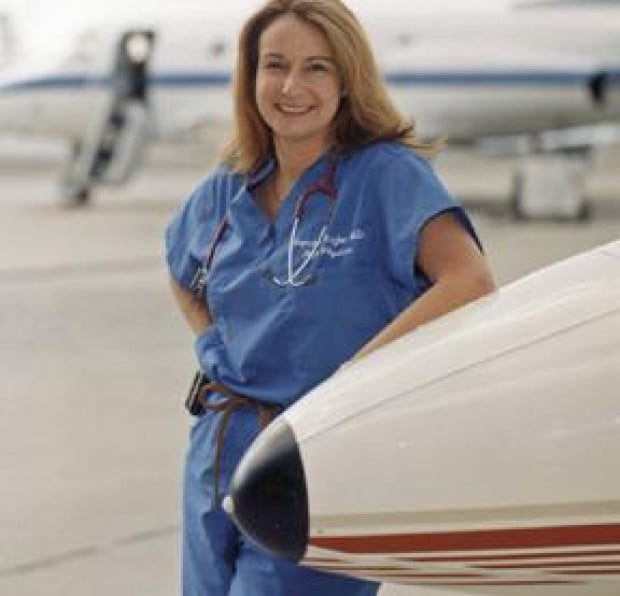
Rescuing and fighting for her patients in extreme physical emergencies worldwide is Fran Vogler’s passion.
By Carla Fischer / Special to The Malibu Times
A young college student ice climbing in Patagonia fell 1,000 feet when one of his carabiners (a metal clip that connects a climber to his rope) broke. Unconscious, and with a blizzard blowing in, his climbing friend, who had paramedical training, made an ice cave for him. They couldn’t be evacuated for 30 hours.
When aid did arrive, it was in the form of AIRescue International, a worldwide medical air ambulance and air evacuation service company created in 1992 by Malibu resident Francine Vogler, M.D. She is president, medical director and founder of the company. AIRescue transported the climber to a hospital in Chile.
“Dr. Vogler provides an unique and invaluable service for world travelers,” said David B. Baron, M.D., of Primary Caring in Malibu. “She brought my patient home from England who had suffered a stroke. The family was very grateful.”
Vogler was residency trained in emergency medicine and was an ER physician in the Los Angeles area for 15 years. As a post-grad in emergency medicine at McGill University in Montreal, she experienced a pivotal turn in personalizing patients. While presenting one day, she referred to her patient as the “chest pain patient in Room 4.”
Her training physician asked, “Are you speaking of Mrs. Jones in Room 4?”
Vogler went on to recognize a tendency in America that depersonalized patients instead of identifying them with a name and face, and remembering patients as a whole person.
On the clinical faculty at USC, she developed a program teaching medical students how to be effective communicators, enhancing their patient-physician communication. Peter Jennings of ABC World News Tonight did an “American Agenda” segment exploring her pioneering work, which has become a regular part of course work in medical schools throughout the nation.
Her work in medical air transport began with UCLA’s clinical faculty and its helicopter MedStar program, until it closed down.
“It was an integrated transfer program involving helicopters, ground ambulance and fixed-wing air ambulance. From 1989 to 1991, the university decided to end the transport program because it was no longer fiscally viable. This closure created a lack of patient services in the area,” Vogler said.
Then a call came in from a friend who had fallen and fractured and dislocated her hip in Milan, Italy.
“They told her she had to stay there three months waiting for it to heal,” Vogler said. “We found a Gulfstream aircraft for $25,000. Another option: an airline stretcher service for $13,000, and we got her insurance company to pay for it. That was our first case.”
“Fran wanted to find a way to provide continuity in the fixed-wing area to transport patients who were ill or injured that needed to be moved in or out of the United States,” said David Percelay, husband and spokesperson for Vogler.
In response to the gap in these services, Vogler created AIRescue, a 24/7 emergency air medical company, based at Van Nuys Airport. It’s a first-responder for a number of university medical programs, including Stanford University’s Lucile Packard Children’s Hospital.
“AIRescue is a private, nonuniversity-based program with medical teams capable of transporting critically ill or injured neonatal and pediatric patients aboard medicalized jets,” Percelay explained. “It’s supported by a combination of health insurance and travel assistance companies, corporate clients, high net worth individuals and celebrities.”
Vogler also serves as medical team manager of California Task Force One, of the Los Angeles City Fire Department’s FEMA/Urban Search & Rescue team that was deployed by military jet on 9/11 to Ground Zero. Vogler and her team led the rescue effort on the rubble pile for the first 10 days following the attack.
Originally from New York City, Vogler recalled how her ambition in the medical field evolved: “I grew up a poor kid with advantages that a lot of people would see as disadvantages. As a science major, I was extremely interested in math, science, physics and chemistry. I wanted to find a way to utilize my interest in science and couple that with my interest in people … One day, I came home and announced, ‘I’m going to medical school.’ I was told I couldn’t do it because ‘women didn’t get into medical school.’ That was the actual, final motivation,” she explained.
She received her medical training at New York Medical College. There were five women in her medical school at the time.
Vogler channels the New York fighting spirit to fight for her patients, not only moving “heaven and earth to facilitate a transport when somebody’s stuck in a place that they don’t want to be stuck in,” but also working with insurance companies to try and get patients’ transport covered.
“I’ve always been tenacious in a way that I don’t let go until I get it done, whether that be plucking someone off a coral atoll in the middle of the Pacific Ocean, when all you get are longitude, latitude and the coordinates and you don’t actually know where someone is located and you have to figure out how to get them out- a combination of maybe a boat, a helicopter, and a jet- or rescuing a young man who fell 1,000 feet while ice climbing in Patagonia,” Vogler said.
AIRescue is in the process of implementing two additional satellite operations, based with staff and planes in the United States and an international site.
The company was honored this month as part of Microsoft’s Small Business Summit’s “Total Technology Makeover Contest.” This technology update will help with its goal to decrease the time needed for life-saving patient transportation.
As for the climber who fell in Patagonia, Vogler said, “I had the pleasure of speaking with him two weeks ago. He has made a full recovery, is now a physician’s assistant and volunteers in Africa and Third World countries teaching emergency training.”

